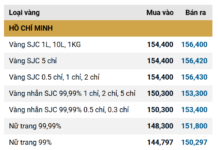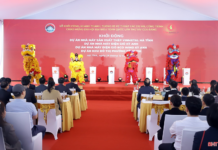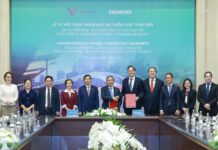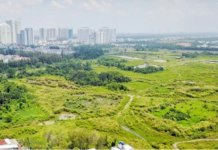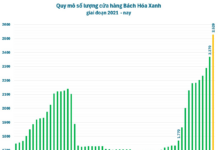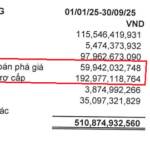At the conference, the Ministry of Planning and Investment announced the approval of the Master Plan for the Southeast Region for the period 2021-2030 with a vision towards 2050 (the “Master Plan”), which was recently endorsed by the Prime Minister.
Delegates discussed reports by the Ministry of Planning and Investment on the implementation of the Master Plan, a review of the one-year implementation of Resolution 24 by the Political Bureau on socio-economic development in the Southeast Region, and the action program by the Government to execute Resolution 24. They also discussed the status of the activities of the Southeast Region Coordination Council and special policies for the region’s development.
The conference also included discussions on reports by the People’s Committee of Ho Chi Minh City regarding proposed mechanisms and policies for the implementation of the Ring Road 4 project, as well as the progress of the Ho Chi Minh City-Moc Bai Expressway project. Additionally, a report by the Ministry of Transport focused on regional connectivity, the Ho Chi Minh City Ring Road 4, and the Chon Thanh-Gia Nghia Expressway.
5 NOTABLE ACHIEVEMENTS
In his concluding remarks, Prime Minister Pham Minh Chinh highlighted five notable achievements in the implementation of Resolution 24 and the activities of the Regional Council over the past year.
Firstly, the organization and completion of the legal framework were carried out swiftly, demonstrating a new mindset, methodology, and approach. Promises were kept, and commitments were fulfilled, resulting in tangible outcomes. The Regional Council was established, its regulations were refined, and three conferences were successfully held, each with relevant and timely themes.
Regarding the improvement of the legal basis, the Government presented to the National Assembly two resolutions: Resolution No. 98/2023/QH15, which includes numerous breakthrough and superior mechanisms and policies applied for the first time, creating favorable conditions for the city’s robust development; and Resolution No. 106/2023/QH15 on piloting several special policies for road construction investment, including essential roads in the region.
The Government also issued Resolution No. 154/NQ-CP on the action program to implement the Resolution of the Political Bureau.
Furthermore, the Government submitted the National Master Plan for the National Assembly’s approval. The Prime Minister approved all six regional plans and is striving to complete the approval of all provincial plans by June 30, with approximately 50% already achieved.

Secondly, statistical data on socio-economic development revealed that the Southeast Region, despite its small area (accounting for 7.1% of the country’s land area and 18.9% of the population), makes significant and crucial contributions to the country, especially in terms of traditional growth drivers.
Thirdly, tangible progress can be observed in infrastructure development, such as the construction of Long Thanh International Airport, the expansion of Tan Son Nhat Airport’s Terminal 3, Ho Chi Minh City’s Ring Road 3, and various expressways. Additionally, several projects have been promoted, including the International Financial Center in Ho Chi Minh City and the Free Trade Center in Ba Ria-Vung Tau (Cai Mep- Thi Vai area)
Fourthly, the secretaries, chairmen, entire political system, local people, and businesses in the region have exerted efforts and fulfilled their responsibilities towards the people, their homeland, and the country.
Fifthly, all provinces and cities in the region demonstrated a strong spirit, motivation, and aspiration for development, actively and proactively implementing their tasks.
“These five points reflect a new momentum, approach, mindset, methodology, and implementation method,” stated the Prime Minister. “However, the region still faces bottlenecks, limitations, and challenges that need to be addressed.”
The Prime Minister acknowledged that the region’s development has not yet fully realized its potential and aspirations. The transition to rapid and sustainable growth has been slow. Cultural development and cultural industries have not matched the region’s heroic historical and cultural traditions as the “Copper City of the Fatherland.” Inter-regional and inter-regional connectivity infrastructure remains limited, and environmental pollution, traffic congestion, and flooding persist as significant issues. Mutual support between localities is hindered by the Law on State Budget, requiring breakthrough thinking for resolution.
6 KEY TASKS AND SOLUTIONS
Looking ahead, the Prime Minister outlined six key tasks and solutions. Firstly, the Ministry of Planning and Investment, in coordination with relevant agencies, was tasked with promptly developing a plan to implement the regional master plan.
Secondly, there should be a focus on restructuring the economic sectors towards modernization, prioritizing the development of strong industries and sectors, promoting in-depth industrial development, and rapidly growing high value-added services, leveraging the region’s strengths (e-commerce, regional-level logistics centers, the international transshipment port in Can Gio, and the Ho Chi Minh City International Financial Center)
Thirdly, priority should be given to investing in key projects with a direct impact on socio-economic development, high spillover effects, international and inter-regional connectivity, and orientation towards the sea. In addition to ongoing projects, new infrastructure projects should be considered, such as the Gia Nghia-Chon Thanh Expressway, the Ho Chi Minh City-Thu Dau Mot-Chon Thanh Expressway, and improvements in railway and waterway infrastructure…
Fourthly, efforts should be directed towards training and developing human resources, attracting talent, promoting innovation, and emphasizing the development of culture, society, and people, improving the quality of life, and providing a healthy living environment for the people.
Fifthly, there is a need to accelerate administrative procedure reform and improve the business investment environment, enhance investment promotion, and thoroughly prepare key projects to attract strategic investors.
Sixthly, regional coordination activities should be strengthened, effectively implementing special mechanisms and policies stipulated in Resolution No. 98/2023/QH15 and Resolution No. 106/2023/QH15 of the National Assembly, as well as other policies issued by the Central Government. This includes promoting inter-regional linkages in developing synchronous socio-economic infrastructure, connecting urban chains, supply chains, logistics, and high-quality services.
The Prime Minister emphasized the importance of enhancing communication and transparency about regional development and the Master Plan, ensuring that people are informed and involved in the process (“People know – People discuss – People do – People inspect – People supervise – People benefit”).
“Ministries, sectors, localities, and agencies should be more proactive, vigorous, and active in researching and implementing breakthrough solutions to execute the Master Plan and the resolutions of the Political Bureau, the National Assembly, and the Government,” the Prime Minister stressed.
ACCELERATING STRATEGIC INFRASTRUCTURE PROJECTS
Regarding specific projects, the Prime Minister assigned Deputy Prime Minister Le Minh Khai to continue directing the resolution of important and cross-sectoral tasks in the process of establishing the regional and international financial center in Ho Chi Minh City.
For the Can Gio International Transshipment Port project, with the political and legal basis already in place, the Prime Minister assigned Deputy Prime Minister Tran Hong Ha to directly oversee the project. He also instructed the Ministry of Transport to expedite the procedures for including the project in the maritime port planning within 10 days.
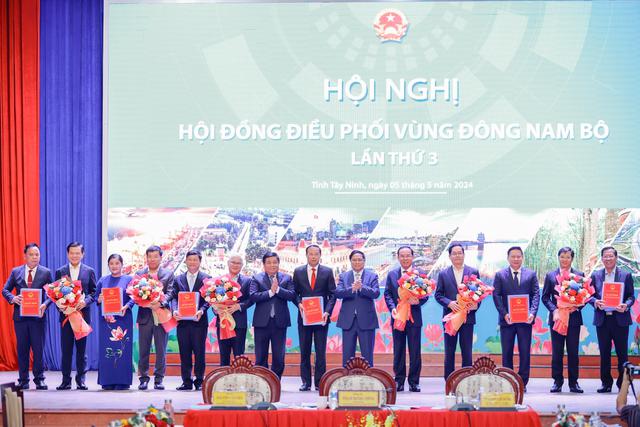
Regarding the Ho Chi Minh City-Moc Bai Expressway project, the Prime Minister instructed the completion of the pre-feasibility study report to ensure the project meets the conditions for the Prime Minister’s decision on the project proposal, with a deadline set for May 15.
For the Gia Nghia (Dak Nong)-Chon Thanh (Binh Phuoc) Expressway project, as the Government has submitted the pre-feasibility study report to the National Assembly, the Prime Minister assigned the Minister of Transport and the Minister of Planning and Investment to closely coordinate with the National Assembly’s agencies during the appraisal process, to be presented at the 7th session of the 15th National Assembly.
Concerning Ho Chi Minh City’s Ring Road 4 project, the Prime Minister agreed with the proposals of the People’s Committee of Ho Chi Minh City and assigned them to finalize the report for submission to the competent authority for consideration and decision-making. He also instructed the Ministry of Planning and Investment and the Ministry of Finance to seek capital balancing solutions, including the mobilization of both central and local funds, the exploration of public-private partnerships, and the issuance of government bonds…
The Prime Minister set the target of essentially completing Long Thanh International Airport in 2025 and inaugurating Tan Son Nhat Airport’s Terminal 3 by April 30, 2025. He also emphasized accelerating the progress of several expressways, particularly the Ho Chi Minh City-Bien Hoa-Vung Tau route.
Concluding the conference, the Prime Minister requested the Ministry of Planning and Investment to synthesize the opinions and draft conclusions of the Chairman of the Regional Coordination Council on key tasks and solutions to implement the Master Plan. These conclusions should clearly define the tasks, solutions, responsible agencies, and timelines, reflecting a higher determination and greater efforts to synchronously and effectively implement the proposed tasks and solutions. The Prime Minister expressed his hope that the Southeast Region, known as the “Copper City of the Fatherland” in the struggle for national independence and unification, would continue to play a pivotal role in socio-economic development in the new era.










